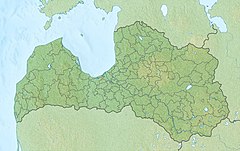Ventspils Starptautiskais Radioastronomijas Centrs

The RT-32 radio telescope
|
|
| Location | Latvia |
|---|---|
| Coordinates | 57°33′13″N 21°51′18″E / 57.553493°N 21.854916°ECoordinates: 57°33′13″N 21°51′18″E / 57.553493°N 21.854916°E |
| Website | virac |
| Telescopes | Irbene RT32 radio telescope |
|
[]
|
|
The Ventspils International Radio Astronomy Centre (Latvian: Ventspils Starptautiskais radioastronomijas centrs – VIRAC) is an ex-Soviet radio astronomy installation 30 km north of Ventspils, Latvia, on the coast of the Baltic Sea in Ance parish. The installation was secret until 1993 after Latvia regained independence. It was taken over by the Latvian Academy of Sciences after the withdrawal of the Soviet Army in 1994. Since then, the two remaining radio telescopes have been repaired.
Located in woodlands near Irbene, in Ventspils, Latvia, the centre was founded in 1974 by the Soviet military. It originally consisted of a 32-metre telescope, along with two smaller telescopes and a communications centre, and was known as Zveolsdoshka, meaning "Little Star". It was possibly used by the KGB during the Cold War to spy on communications between Europe and the USA.
It became a scientific research facility in the 1990s, established on 22 July 1994 as part of the Latvian Academy of Sciences, before becoming an independent organisation on 24 April 1996. It is now known as the Ventspils International Radioastronomy Center ("Ventspils Starptautiskais radioastronomijas centrs"), or the Irbene Astronomy Center.
As of 2015[update], Valdis Avotiņš is the director of the centre.
RT-32 is a 32-metre (105 ft) parabolic radio telescope. It is made up of over 20,000 components, and the central cone weighs 80 tonnes. The fully steerable telescope observes at centimetre wavelengths. The combination of size and precision engineering makes the larger dish especially valuable to scientists. The structure was built by a naval factory in Ukraine, and the interiors are reminiscent of a ship.
...
Wikipedia

